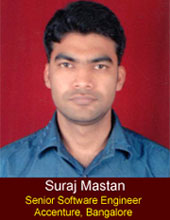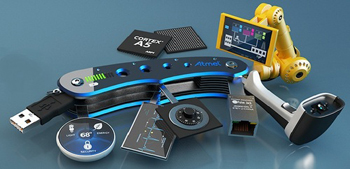Sky Rocketing Careers in Embedded System

Introduction:
 The field of electronics has changed the way we live by making our lifestyles smarter. Our household lives are very much dependent on electronic appliances such as washing machines, refrigerators, microwaves, AC’s and even cell phones. All these are the examples of embedded system applications. By these examples, we can understand the role of embedded systems in our life. Embedded systems are special systems that are meant to perform a dedicated task and these are application-bounded systems. Here processing unit is completely encapsulated by the device it is connected. Most of the embedded systems are microcontroller based than microprocessor.
The field of electronics has changed the way we live by making our lifestyles smarter. Our household lives are very much dependent on electronic appliances such as washing machines, refrigerators, microwaves, AC’s and even cell phones. All these are the examples of embedded system applications. By these examples, we can understand the role of embedded systems in our life. Embedded systems are special systems that are meant to perform a dedicated task and these are application-bounded systems. Here processing unit is completely encapsulated by the device it is connected. Most of the embedded systems are microcontroller based than microprocessor. Definition 1: “An embedded system is a microprocessor-based system that is built to control a function or range of functions and is not designed to be programmed by the end user in the same way that a PC is.”
- Steve Heath
Definition 2: An embedded system is a single-purpose computer built into a larger system for the purposes of controlling and monitoring the system. A general-purpose computer (e.g. a personal computer) is defined not to be an embedded system.
– Arnold. B
Note: The sensitive difference between computer system and embedded system is, computer performs various tasks, where as embedded system is designed for dedicated task or tasks.
Examples of Embedded Systems
The application of embedded system varies from personal devices to complex systems like aircrafts and military systems. Following lists provides some of the the examples of embedded systems:
- Aircraft systems (Eg: auto pilot system)
- Military systems (Missiles, tankers, etc.,)
- Biomedical systems (Eg: scanning systems)
- Automobile industry (Eg: antilock braking system)
- Communications (Satellites, network routers, switches)
- Consumer Goods (TV, washing machines, Mobile phones, ovens etc)
- Industrial equipment( PLC’s, elevator controls, surveillance systems, CNC machines, etc)
Sensors: Eyes, Ears, Skin, Nose, tongue
Buses: Neurons
Microcontroller: Brain
Embedded s/w: Thinking process
The sensors (eyes, ears, skin etc…) input information through neurons (buses) to brain (microcontroller), which processes the information based on knowledge and necessary action (here embedded s/w) is taken.
Characteristics
The toughness in embedded systems comes with its design. As these systems need give high performance at a low cost, designers keep this factor in mind while designing.
The characteristics of embedded system are:
- Single functioned: Dedicated, computer-based system for an application or product.
- Tightly Constrained: Addresses the issue of the response time constraints of various tasks of the system
- S/w usually embedded in ROMs i.e. no need of secondary memories.
- Reactive and Real-Time
- Multi-rate
- Components:
 Embedded system has three components as shown below:
Embedded system has three components as shown below:
Embedded H/w:
Microcontroller, Timers, Serial Communication Devices, Interrupt controller, Parallel Ports, Input/Output Interfacing and/or driver circuits, sensors, System Application Specific Circuits, Power Supply, Reset and Oscillator Circuits.
Embedded S/w:
The embedded software instructs the embedded hardware to perform a specific task. The concept of code optimization and hardware utilization are two important design constraints one has to remember in developing embedded software.
OS:
The supervision of the embedded application s/w application and providing mechanisms to the processor for better clock per cycle utilization is achieved by the mechanism called as Real Time Operating System (RTOS)”. It provides algorithms to perform context switching between various processes (tasks). It organizes access to a resource in sequence of the series of tasks of the system. It is of two types:
- Hard real time system
- Soft real time system
Whereas Soft real time are not time bounded systems. Delay in task execution is of not much importance. Rather it focuses on sequence for the task-operations. EX: Toys, Mobile phones...
- Embedded Systems Classification:
The classification of embedded system has been three types stated below:
a) Small
b) Medium
c) Large
Note: The classification has been done based on the factors of complexity of hardware and software.
The complete spectral view of the classification presented compactly in the form table below:
| Features | Small scale | Medium scale | Large scale |
| processing | Single 8-bit / 16-bit microcontroller (µC) | Single or few 16-bit / 32-bit µC or DSPs or RISCs | Scalable processors or configurable processors and PLAs |
| H/W and S/W complexities | Little | Have both (medium) | Enormous (large) |
| Design methods | Board-level | H/W S/W co-design | H/W S/W co-design |
| Programming and Development Tools | Editor / assembler/ cross-assembler / development boards | RTOS / Source code engineering tools / simulators / debugger and Integrated Development Environment (IDE) | May not be readily available. A compiler or re-targetable compiler might have to be developed. |
| Constraints | S/w should fit into the memory available. | With respect to h/w and s/w complexities | Processing speeds of h/w units reduce performance and speed |
| Application specific circuits | Not needed | ASSPs and IPs needed (e.g. bus interfacing, encrypting, deciphering, discrete cosine transformation and inverse transformation, TCP/IP protocol stacking & network connecting functions) | Needed but implemented in h/w to maximize speed by saving time. Some h/w resources in the system are also implemented by s/w. |
| Skills required by a developer | Understanding of microcontrollers, computer architecture and organization, digital electronic design, s/w engg., data communication, control enng., motors and actuators, sensors and measurements, analog electronics design and IC design etc. | ‘C’ and RTOS programming, program modeling skills, h/w organisation and use of APIs for a specific microcontroller. | Embedded Sys. h/w Designer: Full skills in h/W units and basic knowledge of ‘C’, RTOS and other programming tools. |
Institutes offering courses:
- CDAC
- ThinkLABS
- Sigma solutions
- VECTOR Institute
- CMS Institute
- UTL Technologies Ltd
- CMS Institute
- Ameya Centre For Robotics & Embedded Technology
- India Institute of VLSI Design And Training
An embedded system is all set to revolutionizing all the fields and assures embedded engineers a jubilant future. Following are some of the institutions and companies that are working in the area of embedded systems development:
- Patni,
- CDAC,
- ISRO
- DRDO
- Hughes Pvt. Ltd.
- Pentagram Private Ltd.
- TECh Mahindra
- QUALCOMM
- Alcatel Lucent
- C & C++ Programming (Mandatory)
- Device driver development
- Linux/Unix/Windows
- Device driver programming
- Soldering
- Embedded System Engineer
- Embedded Engineer
- Research Associate
- Device Driver Programmer
| Funny as it may seem, for most of us, not a day would pass by without using a phone - an embedded device! In our modern lives, we have reached to a stage where embedded devices have become a necessity. The digital revolution has presented us with this boon and the immense power that these little devices hold, is yet to be unveiled and utilized to a full extent. The colossal potential of embedded systems has led to it being the most sought after field of research and realizing this many corporate industries are alluring engineers to give in their innovative ideas. Clearly, there is a huge scope for this field and the industry is in need of candidates adept with the technology, those willing to cope up with the current trends of this fast growing technology. The prospects of embedded systems are worldwide and those who can pull it through the steep learning curve of this technology can have a wonderful career. G. Prashanthi (MS Electronics) Sr. Research Engineer, Pentagram Research Centre Pvt. Ltd www.pentagramresearch.com |



















